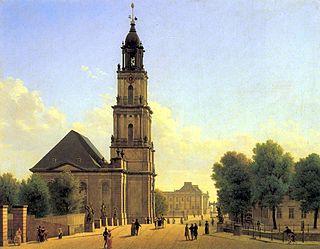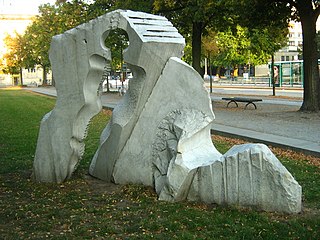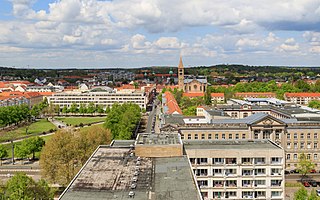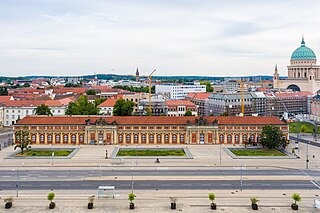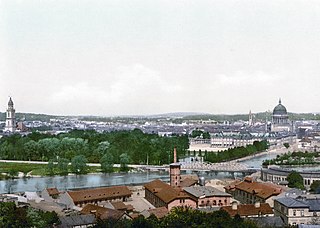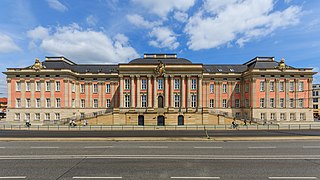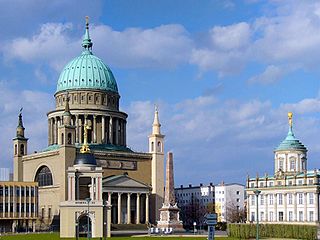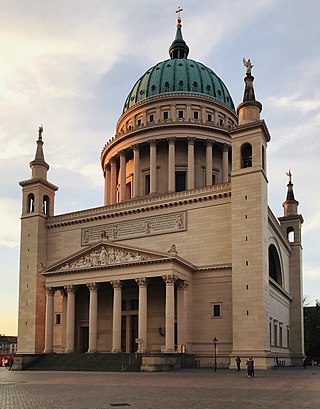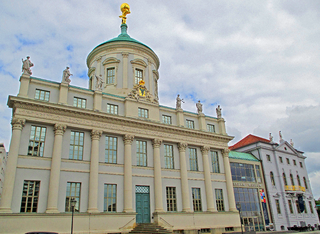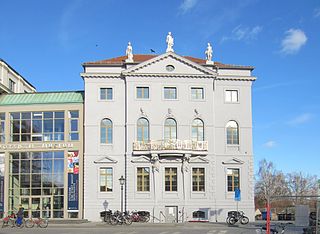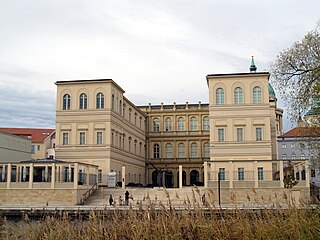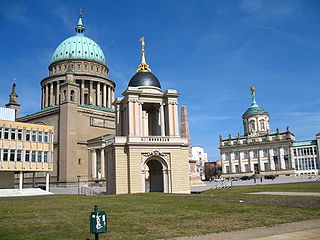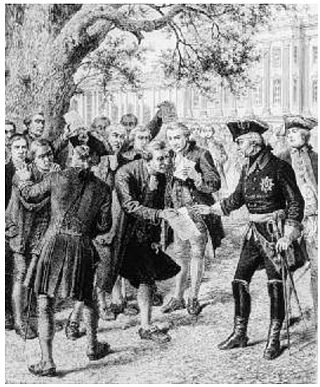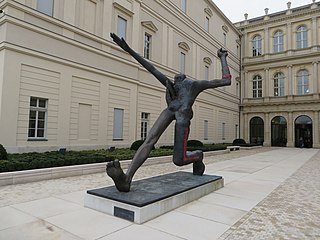Self-guided Sightseeing Tour #2 in Potsdam, Germany
Legend
Guided Free Walking Tours
Book free guided walking tours in Potsdam.
Guided Sightseeing Tours
Book guided sightseeing tours and activities in Potsdam.
Tour Facts
5.4 km
111 m
Experience Potsdam in Germany in a whole new way with our free self-guided sightseeing tour. This site not only offers you practical information and insider tips, but also a rich variety of activities and sights you shouldn't miss. Whether you love art and culture, want to explore historical sites or simply want to experience the vibrant atmosphere of a lively city - you'll find everything you need for your personal adventure here.
Activities in PotsdamIndividual Sights in PotsdamSight 1: Seerose

The Seerose Potsdam is a waterfront pavilion in Potsdam, Germany. The eight-fold curved roof structure in the form of a leaf rosette is a hypar shell construction and was designed by civil engineer Ulrich Müther. The building was placed under monument protection by the Brandenburg State Monuments Office on 21 December 2004. The architectural style of the water lily is assigned to organic architecture.
Sight 2: Predigerwitwenhaus
The Predigerwitwenhaus is a listed building in the northern city center of Potsdam, Breite Straße 14 [formerly 25].
Wikipedia: Predigerwitwenhaus (Potsdam) (DE), Heritage Website
Sight 3: Hiller-Brandtsche Häuser
Hiller-Brandt houses are the buildings completed in 1769 at Breite Straße 8 to 12 in Potsdam. King Frederick II had the two town houses rebuilt with a uniform façade according to plans by Georg Christian Unger and expanded by a barracks. The building is named after its users, the merchant Johann Friedrich Hiller and the master tailor Johann Gebhardt Brandt. Since the renovation, the listed building has housed rental and owner-occupied apartments since 2013.
Sight 4: Garnisonkirche
The Garrison Church was a Protestant church in the historic centre of Potsdam. Built by order of King Frederick William I of Prussia according to plans by Philipp Gerlach from 1730 to 1735, it was considered as a major work of Prussian Baroque architecture. With a height of almost 90 metres, it was Potsdam's tallest building and shaped its cityscape. In addition, the Garrison Church was part of the city's famous "Three Churches View" together with the St. Nicholas Church and the Holy Spirit Church. After it was damaged during the British bombing in World War II, the East German authorities demolished the church in 1968. After the German reunification, the Garrison Church is currently being rebuilt as a centre for remembrance and reconciliation. The first section opened in 2024, containing a Coventry chapel, an exhibition about the history of the place and a viewing platform at a height of 57 meters.
Wikipedia: Garrison Church (Potsdam) (EN), Facebook, Website
Sight 5: Brandenburg Museum für Zukunft, Gegenwart und Geschichte
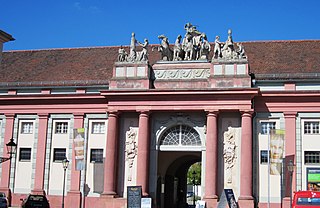
The Brandenburg Museum for Future, Present and History, until 2024 House of Brandenburg-Prussian History, is a museum on the Neuer Markt in Potsdam, which is located there in the carriage horse stable. It sees itself as an open forum for active engagement with Brandenburg and Prussian history.
Wikipedia: Brandenburg Museum (DE), Tiktok, Facebook, Linkedin, Instagram, Website, Vimeo, Youtube
Sight 6: Deserteurdenkmal
The marble sculpture Monument to the Unknown Deserter was created in 1989 at the instigation of the "Bonn Peace Plenum" by the Turkish sculptor Mehmet Aksoy, who was living in Berlin at the time.
Sight 7: Platz der Einheit
The Platz der Einheit is one of the oldest squares in Potsdam, along with Bassinplatz and the Plantage. Laid out under the Soldier King Friedrich Wilhelm I, the square is bordered by the Wilhelmgalerie in the north, residential buildings in the east, the street Am Kanal in the south and the Friedrich-Ebert-Straße in the west. It is an important public transport hub.
Sight 8: Synagogenzentrum Potsdam
Sight 9: Marstall
The Marstall is an architectural monument on Breite Straße in Potsdam. Built in 1685 by Johann Arnold Nering in the Baroque style as an orangery, it has been rebuilt and expanded several times in the course of history. The former riding horse stable of the city palace is the oldest surviving building in the city and has been home to the Potsdam Film Museum since 1981.
Wikipedia: Marstall (Potsdamer Stadtschloss) (DE), Heritage Website
Sight 10: Filmmuseum Potsdam
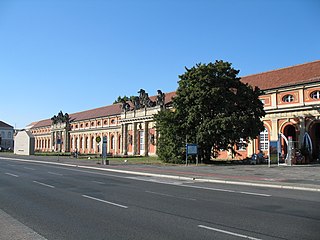
The Filmmuseum Potsdam was founded in 1981 as the "Film Museum of the GDR", making it the oldest film museum with its own collection and exhibitions in Germany and receiving its current name in 1990. It has been under the sponsorship of the state of Brandenburg since 1991 and is part of the Film University Babelsberg. At the centre of the collections and the permanent exhibition are the world's oldest film studio in Babelsberg, its film productions and the artists who worked there on films by Bioscop, Ufa, DEFA and Studio Babelsberg. Temporary exhibitions, family exhibitions and foyer exhibitions on German and international film and media topics complement the exhibition programme. The Film Museum operates a museum shop and a cinema with several screenings daily, silent film screenings are accompanied by music on the historic Welte cinema organ.
Sight 11: Casino Potsdam
The houses at Schloßstraße 13 and 14 in Potsdam are protected buildings as architectural monuments.
Sight 12: Neuer Lustgarten
Der Lustgarten war die älteste Gartenanlage in Potsdam. Seine damalige Fläche wird von der Breiten Straße mit dem Marstall im Norden, der Havel im Osten, dem Bahndamm im Süden und dem Innenministerium im Westen umrahmt. Als Barockgarten unter dem Großen Kurfürsten Friedrich Wilhelm für das Stadtschloss geschaffen und unter König Friedrich Wilhelm I. zur Hälfte in eine Exerzierfläche verwandelt, wurde das Übrige durch Friedrich II. und 1829 von Peter Joseph Lenné umgestaltet. Nach dem Zweiten Weltkrieg wurde der beschädigte Lustgarten mit dem Ernst-Thälmann-Stadions und später mit dem Interhotel Potsdam überbaut. Anlässlich der Bundesgartenschau 2001 wurde nach dem ersatzlosen Abriss des Stadions der größtenteils versiegelte Neue Lustgarten als Veranstaltungsfläche angelegt.
Sight 13: Ringerkolonnade
The Potsdam City Palace is a building in Potsdam, Germany, located on the Old Market Square, next to the St. Nicholas' Church (Nikolaikirche). It was the second official residence of the margraves and electors of Brandenburg, later kings in Prussia, kings of Prussia and German emperors.
Sight 14: Alter Markt
The Old Market Square is a centrally located square in downtown Potsdam which forms the historical centre of the city. The square consists of the area around St. Nicholas' Church. Today the term refers in particular to the area directly in front of the church. It is bordered by several prestigious historical buildings. The square has been the site of much architectural reconstruction work in recent years which has restored much historic building fabric that was lost in World War II.
Wikipedia: Old Market Square, Potsdam (EN), Heritage Website
Sight 15: Obelisk
The obelisk is a monument on the Alter Markt in Potsdam. It was built between 1753 and 1755 by order of Frederick the Great according to a design by Georg Wenzeslaus von Knobelsdorff.
Sight 16: St. Nikolaikirche
St. Nicholas Church in Potsdam is a Lutheran church under the Evangelical Church in Berlin, Brandenburg and Silesian Upper Lusatia of the Evangelical Church in Germany on the Old Market Square in Potsdam. The central plan building in the Classicist style and dedicated to Saint Nicholas was built to plans by Karl Friedrich Schinkel in the years 1830 to 1837. The tambour of the 77-metre-high church that towers above the roofs of the city was built later, from 1843 to 1850. Its construction was taken over by Ludwig Persius and, from 1845, Friedrich August Stüler.
Wikipedia: St. Nicholas Church, Potsdam (EN), Website, Heritage Website
Sight 17: Altes Rathaus
The Old Town Hall is a Palladian secular building on the Alter Markt in Potsdam. It was built between 1753 and 1755 on behalf of Frederick the Great according to designs by Johann Boumann and Carl Ludwig Hildebrandt. The model was the Palazzo Angarano in Vicenza, designed by Andrea Palladio but not executed. Damaged in the air raid on Potsdam in 1945, the Old Town Hall was rebuilt from 1961 to 1966. Since 2012, it has been the seat of the Potsdam Museum.
Sight 18: Potsdam Museum
The Potsdam Museum – Forum for Art and History, founded at the beginning of the 20th century, has one of the largest collections of art, cultural and regional history in the state of Brandenburg with over 250,000 objects. The collection reflects the civic commitment and passion for collecting of the founding years. The diverse collections include cultural-historical and military-historical areas as well as works of artistic creation.
Sight 19: Knobelsdorff-Haus
The Lehmannsche Haus, also known as the Knobelsdorffhaus, is a Palladian town house on the Alter Markt in Potsdam, Germany. It was built in 1750 by order of Frederick the Great according to a design by Georg Wenzeslaus von Knobelsdorff. The Marble Hill House in Twickenham served as a model.
Sight 20: Museum Barberini
The Museum Barberini is an art museum in Potsdam opened in 2017. Its exhibitions range from the so-called Old Masters to contemporary art, with an emphasis on impressionist painting. Centered around works from the collection of its founder and patron Hasso Plattner, the Barberini presents three temporary exhibitions per year, featuring loans from international museums and private collections. Academic conferences serve to prepare these exhibitions. At the same time, shorter gallery displays – the so-called “art histories” – put works from the collection into constantly shifting contexts. The museum aims to offer a diverse programme of events and educational activities as well as digital offers like the Barberini App and the 4K Smart Wall in the museum.
Wikipedia: Museum Barberini (EN), Twitter, Facebook, Instagram, Website, Youtube
Sight 21: Fortunaportal
The Fortuna Portal on the Old Market Square in Potsdam, opposite the Church of St. Nikolai, was designed by the Dutch architect Jean de Bodt in 1701 as the entrance gate to the Potsdam City Palace and inaugurated in 1701 on the occasion of the self-coronation of Elector Frederick III as King Frederick I of Prussia. Since then, the construction of the Fortuna Portal has been regarded as the beginning of classical Potsdam architecture.
Sight 22: Bittschriftenlinde
The petition linden tree stood in Potsdam in Humboldtstraße, at the southern corner of the City Palace. It was the most famous tree in the city. On the site of the original tree there is now a second lime tree, which is also called the petition lime tree.
Sight 23: Der Jahrhundertschritt
The Step of the Century is a bronze sculpture that was created by Wolfgang Mattheuer in 1984. It is considered one of the most important works of art in the GDR at the time of the division of Germany and is a parable of the turmoil of the 20th century.
Sight 24: Nuthepark
The Nuthepark is a near-natural landscape park in Potsdam. The park stretches along the east bank of the Havel south and north of the mouth of the Nuthe, starting in the south at Potsdam Central Station to Babelsberg Park. It was newly created between 1998 and 2001 in the course of preparations for the Federal Garden Show 2001 on a fallow site. To connect the two parts, the Nuthe is spanned by a pedestrian and cyclist bridge shortly before the mouth. The green spaces newly created in 2020 by the Investment Bank of the State of Brandenburg are to merge with the areas of the Nuthepark in the future.
Sight 25: NANO – Wissenschaft begreifen
The NANO Science Center is a scientific, didactic institution with an exhibition in Potsdam.
Wikipedia: Extavium (DE), Facebook, Instagram, Website, Youtube
Share
How likely are you to recommend us?
Disclaimer Please be aware of your surroundings and do not enter private property. We are not liable for any damages that occur during the tours.
GPX-Download For navigation apps and GPS devices you can download the tour as a GPX file.


